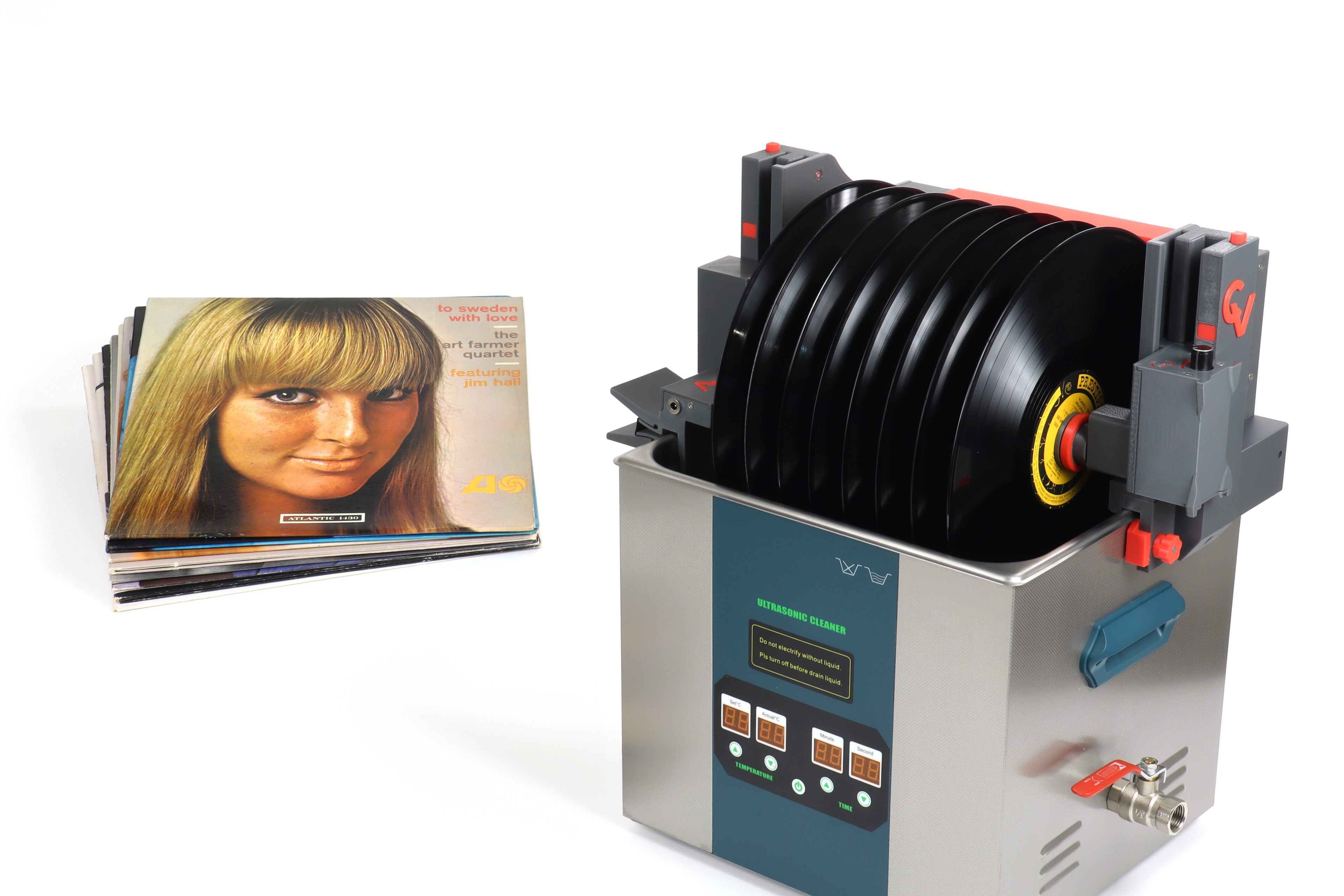Frequently Asked Questions About Ultrasonic Record Cleaning
More questions? Get in touch: info@cleanervinyl.com
How does ultrasonic vinyl record cleaning work, and what is the main difference to 'classic' cleaning methods?
Ultrasonic cleaning is a very different approach compared to classic 'brush and wand' based cleaning methods. There is no mechanical interaction between a cleaning tool and the vinyl surface, which means no damages are introduced by the cleaning process. Read more here.
What is the best spacing between records during the ultrasonic cleaning process?
Ultrasonic cleaning is able to penetrate into very small gaps and crevices. This means spacing is not very important as long as the cleaning fluid can get to the surface of the records. However...read more here.
What is the best RPM or speed for spinning the vinyl records through the ultrasonic cleaner?
There is a lot of discussion on this topic out in the 'analog audio space'. We recommend trying different RPMs to find the best speed for your particular cleaning situation. Read more here.
Why should I choose CleanerVinyl products for my ultrasonic record cleaning needs?
CleanerVinyl products are designed and manufactured in the US by vinyl record enthusiasts. From this personal vinyl collecting experience follows that...
...our products have an ergonomic design that allows record loading 'away from the ultrasonic'
...our tank attachments do not damage the tanks. There are no screw clamps and the like that dent the rim etc...
...our products have universal fit, i.e. fit most cleaner brands with standard tubs. So you are not locked in with a certain ultrasonic unit. This makes replacement or upgrades easy.
...we offer the best in class water filtration with our Micron filtration system, which can filter particles smaller than one micron. This eliminates re-deposition of dirt and you can use the water for many batches of records before replacement becomes necessary.
Can vinyl records be dissolved by the cleaning fluid during the ultrasonic process?
There is nothing to worry about. Since the 1950s most vinyl records were made from polyvinyl chloride (PVC).
PVC is one of the most resistant plastics and is chemically resistant to water, acids, bases, fats, and alcohols. One primary application of PVC is protective coatings against the environment and sewage pipes, i.e. the usual distilled water with wetting agent and/or alcohol mixtures used in vinyl record cleaning does not represent a challenge for your records.
Note, however, that pre-1950 records can be made from shellac coated metal discs. Shellac is a material that can be dissolved by alcohol, i.e. we recommend to stay away from distilled water/alcohol mixtures for shellacs cleaning.
Why do CleanerVinyl ultrasonic record cleaning systems not use large spacers with O-rings for protecting the labels?
Large spacers with O-rings are not necessary. The surface tension of the cleaning fluid keeps it on the vinyl surface. Watch a short video demonstrating this effect.
What is the benefit of adding a wetting agent to the water?
Wetting agents like Kodak Photo-Flo, Ilford Ilfotol or Tergikleen were developed to prevent droplets on surfaces. They break the surface tension of water promoting the formation of a continuous and homogeneous fluid film on the vinyl record. Read more here.
Does the Micron cleaning fluid filtration system remove the wetting agent?
Only a very small amount when a new filter is being used. Read more here.
How many records can I clean before I need to replace the cleaning fluid during ultrasonic record cleaning?
Without a filtration system we recommend to exchange the fluid after a few batches of records. This of course depends on the level of contamination on the records. With Micron filtration the water can last for many more batches. Read more here.
Why should one use fluid filtration for cleaning vinyl records with an ultrasonic cleaner?
CleanerVinyl Micron filtration removes the dirt from the water during the cleaning process. This eliminates redeposition of dirt. It also strongly increases the number of batches of records that can be cleaned before the water needs to be replaced
Why do CleanerVinyl ultrasonic vinyl record cleaning products use air drying instead of wiping or vacuuming?
Air drying is touchless, low effort and high throughput. It does not introduce static charges and it does not introduce new contamination. Read more here.
How does the ultrasonic cleaner frequency influence the vinyl record cleaning result?
Generally, one can say that low frequencies are better for the removal of coarse dirt, while higher frequencies are better for the removal of smaller items like large molecules or bio materials. Our multi-frequency cleaners cover the entire spectrum for an audiophile cleaning result. Read more here.
What is the best cleaning fluid recipe for ultrasonic vinyl record cleaning?
There are a lot of 'recipes' discussed around the internet. Our own experience is that all you need is a bit of wetting agent and maybe sometimes a few percent alcohol. Most expensive additives that are sold consist mostly of these two ingredients and maybe a bit of food coloring to make them look blue.
Ultrasonic cleaning is different from other cleaning methods since most of the cleaning action comes from the cavitation of the bubbles. Surfactants help getting the bubbles closer to the surface and alcohol can help with greasy residues if there are a lot of finger prints or similar.
